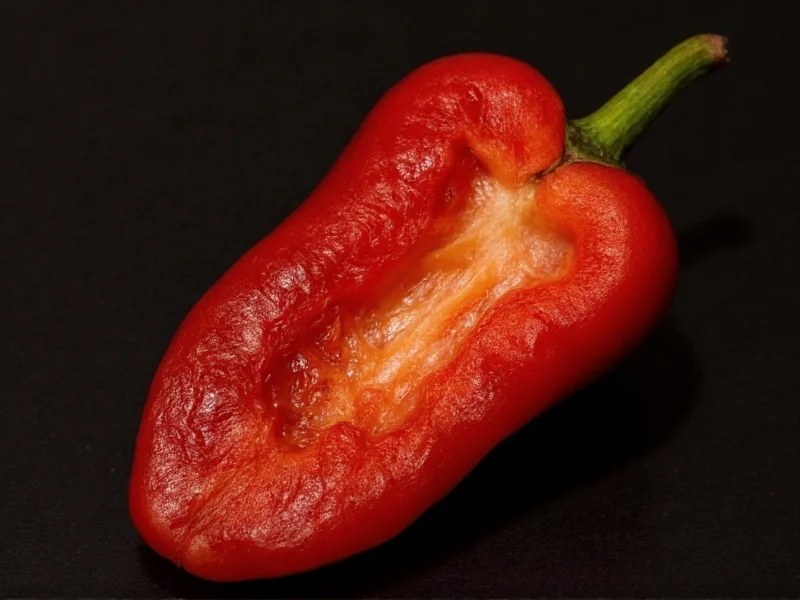The Scoville scale remains the standard measurement for chili pepper heat, quantifying the concentration of capsaicinoids that produce that burning sensation. Ghost peppers, scientifically known as Capsicum chinense 'Bhut Jolokia', earned global recognition when they were certified as the world's hottest pepper by Guinness World Records in 2007, holding that title until 2011.
Understanding Scoville Heat Units
Developed by pharmacist Wilbur Scoville in 1912, the Scoville Organoleptic Test originally measured heat through human taste panels diluting pepper extracts until the heat became undetectable. Today, high-performance liquid chromatography (HPLC) provides precise measurements of capsaicinoid content, which are then converted to Scoville Heat Units for consumer understanding.
Ghost Pepper SHU Range Explained
Research from New Mexico State University's Chile Pepper Institute confirms ghost peppers consistently register between 855,000 and 1,041,427 SHU. This wide range reflects natural variations influenced by:
- Soil composition and growing conditions
- Climate and weather patterns during cultivation
- Genetic variations between individual plants
- Ripeness at harvest time
| Pepper Variety | Scoville Heat Units (SHU) | Heat Comparison to Jalapeño |
|---|---|---|
| Ghost Pepper (Bhut Jolokia) | 855,000 - 1,041,427 | 200-400x hotter |
| Habanero | 100,000 - 350,000 | 20-60x hotter |
| Cayenne | 30,000 - 50,000 | 6-10x hotter |
| Jalapeño | 2,500 - 8,000 | Baseline |
| Bell Pepper | 0 | No heat |
Physical Characteristics and Effects
Ghost peppers typically measure 2.4-2.8 inches long with a distinctive wrinkled, tapered shape. Their vibrant red color indicates full ripeness and maximum capsaicin concentration. When consumed, ghost peppers produce an immediate burning sensation that intensifies over 30-45 seconds, often causing:
- Profuse sweating and flushing
- Tearing eyes and runny nose
- Temporary numbness in the mouth
- Increased heart rate
The delayed peak intensity makes ghost peppers particularly challenging, as the initial heat seems manageable before escalating dramatically. This delayed reaction often leads to accidental overconsumption.
Safety Considerations for Handling Ghost Peppers
Due to their extreme heat level, proper handling techniques are essential when working with ghost peppers:
- Always wear nitrile gloves when cutting or processing
- Avoid touching your face, especially eyes, during preparation
- Work in well-ventilated areas to prevent inhaling capsaicin particles
- Have dairy products (milk, yogurt) readily available to counteract heat
- Never use plastic gloves, as capsaicin can penetrate them
Medical professionals warn that direct skin contact can cause chemical burns, while inhaling ghost pepper particles may trigger respiratory distress in sensitive individuals. If accidental exposure occurs, wash the affected area thoroughly with soap and water, then apply a mixture of baking soda and water to neutralize the capsaicin.
Historical Context and Origin
Despite their "ghost" moniker, these peppers originated in Northeast India, where they've been cultivated for centuries. The name "Bhut Jolokia" translates to "ghost chili" in Assamese, referring to how the heat seemingly sneaks up on you. Indian military researchers discovered their extraordinary heat potential while developing non-lethal deterrents, leading to the formal testing that earned them the world's hottest pepper title.
Practical Uses of Ghost Peppers
While consuming ghost peppers raw is inadvisable for most people, they serve several legitimate purposes:
- Specialty hot sauces (used in minute quantities)
- Pepper spray formulations (significantly hotter than standard versions)
- Culinary applications in extremely small amounts for heat infusion
- Traditional medicine in native regions
- Wildlife deterrents (elephants in India)
Chefs who work with ghost peppers emphasize that a single pepper can season multiple dishes. When used properly, they provide complex fruity undertones beneath the intense heat, making them valuable for experienced cooks seeking extreme heat profiles.
Ghost Pepper vs. Newer Superhot Varieties
While ghost peppers dominated the heat charts for years, newer cultivars have surpassed them:
- Trinidad Moruga Scorpion: 1.2-2 million SHU
- Carolina Reaper: 1.4-2.2 million SHU
- Pepper X: Reported up to 3.18 million SHU
Despite being dethroned, ghost peppers remain significantly hotter than most commercially available peppers and continue to challenge even experienced heat seekers. Their accessibility and consistent heat profile maintain their popularity among chili enthusiasts.
How many times hotter is a ghost pepper than a jalapeño?
A ghost pepper is approximately 200-400 times hotter than a jalapeño pepper. With ghost peppers measuring 855,000-1,041,427 SHU compared to jalapeños at 2,500-8,000 SHU, even the mildest ghost pepper significantly exceeds the hottest possible jalapeño.
Can eating a ghost pepper be dangerous?
While consuming a ghost pepper won't kill a healthy adult, it can cause significant discomfort including severe burning pain, nausea, vomiting, and temporary breathing difficulties. Medical attention may be needed for extreme reactions, particularly in children or individuals with pre-existing conditions. The capsaicin concentration in ghost peppers exceeds what most people's digestive systems can comfortably process.
How long does ghost pepper burn last?
The intense burning sensation from a ghost pepper typically peaks within 30-45 seconds of consumption and can last 20-45 minutes in the mouth. Complete elimination of the sensation may take several hours as the body metabolizes the capsaicin. Dairy products like milk or yogurt provide temporary relief by binding to capsaicin molecules.
What's the difference between ghost pepper and bhut jolokia?
Ghost pepper and Bhut Jolokia refer to the exact same chili pepper variety. "Bhut Jolokia" is the original Assamese name meaning "ghost chili," while "ghost pepper" is the English translation that became popular internationally. Both terms describe the Capsicum chinense cultivar that measures 855,000-1,041,427 SHU on the Scoville scale.
Why does ghost pepper heat feel delayed?
Ghost peppers contain capsaicinoids that activate TRPV1 receptors in the mouth, but the specific chemical composition causes a delayed reaction. The initial contact feels moderately hot, then the sensation intensifies dramatically over 30-45 seconds as more capsaicin binds to receptors. This delayed peak is what makes ghost peppers particularly challenging, as people often consume more than intended before the full heat registers.











 浙公网安备
33010002000092号
浙公网安备
33010002000092号 浙B2-20120091-4
浙B2-20120091-4